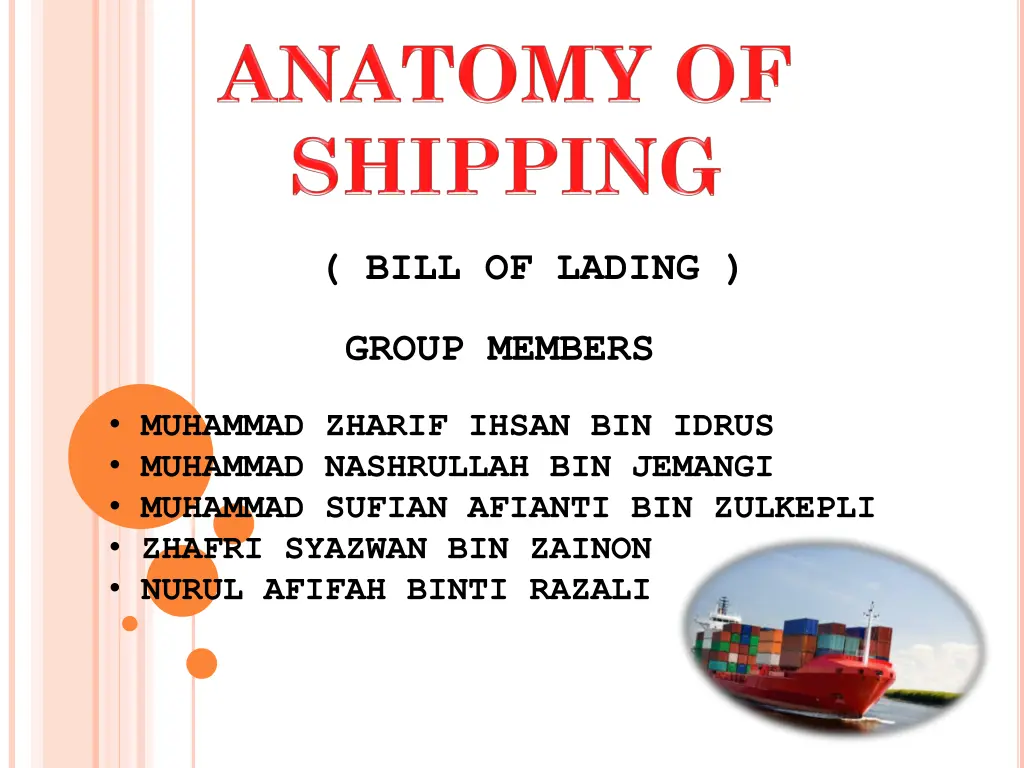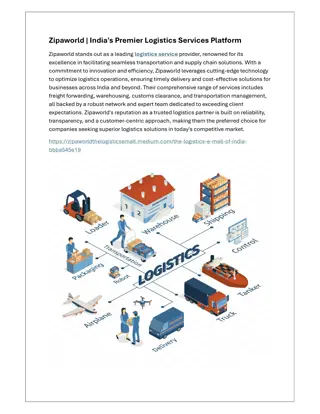
Understanding the Various Types of Bill of Lading and its Importance
Explore the significance and types of Bill of Lading - a crucial document in shipping. Dive into concepts like Negotiable BOL, Ocean vs. Inland BOL, and more. Discover how it impacts goods transportation and ownership transfer.
Download Presentation

Please find below an Image/Link to download the presentation.
The content on the website is provided AS IS for your information and personal use only. It may not be sold, licensed, or shared on other websites without obtaining consent from the author. If you encounter any issues during the download, it is possible that the publisher has removed the file from their server.
You are allowed to download the files provided on this website for personal or commercial use, subject to the condition that they are used lawfully. All files are the property of their respective owners.
The content on the website is provided AS IS for your information and personal use only. It may not be sold, licensed, or shared on other websites without obtaining consent from the author.
E N D
Presentation Transcript
( BILL OF LADING ) GROUP MEMBERS MUHAMMAD ZHARIF IHSAN BIN IDRUS MUHAMMAD NASHRULLAH BIN JEMANGI MUHAMMAD SUFIAN AFIANTI BIN ZULKEPLI ZHAFRI SYAZWAN BIN ZAINON NURUL AFIFAH BINTI RAZALI
A document issued by a carrier to the shipper as a contract of carriage of goods. Contract between the owner of the goods. There are two types of BOL.
The negotiable BOL can be bought, sold, or traded while the goods are in transit. The usually need an original as proof of ownership to take possession of the goods. customer will
Evidence of terms of contract Receipt for goods shipped A transferable document of title of goods
If a consignment is transported by sea, nationally or internationally Bill of Lading is used. Ocean Ocean Bill of Lading is a common term used in shipping.
Inland Bill of Lading is the bill of lading which allows carrier to ship cargo, by road or rail, across domestic land, but not over seas. the shipping
This is a type of Through Bill of Lading that involves a minimum of two different modes of transport, land or ocean. The modes of transportation can be anything from freight boat to air.
Direct Bill of Lading is used when you know the same vessel that picked up the cargo will deliver it to its final destination.
If a consignment with no damage on packages apparently, issues a Bill of lading called Clean Bill of Lading. the carrier
A consignment with no damage on packages apparently and if such consignment gone on board the vessel, a Clean On Board Bill of Lading is issued by carrier of goods.
If owner of ship or his agent does not agree with one or more of the statements mentioned in the bill of lading, he add the said clause or clauses on the bill of lading. This bill of lading is called unclean bill of lading.
A Shipped On Board Bill of Lading is issued when the cargo arrives at the port in good, expected condition from the shipping carrier and is then loaded onto the cargo ship for transport over seas.
Received for shipment bill of lading can be issued to shipper immediately up on receipt of goods by the carrier after necessary export procedures of exporting country. customs clearance
Under a Through Bill of Lading, the shipping carrier can pass the cargo through several different modes of transportation or several different distribution centres.
A Bill of Lading can be treated as Stale , if it is presented long after sailing of vessel pertaining to a shipment at port of loading. Presentation of Bill of Lading could be with the Supplier s Bank, Discounting Bank, Negotiating Bank, Buyer s Bank or buyer.
It is a non negotiable Bill of Lading where in no payment is required against the goods. The carrier of goods release cargo to consignee on production of identity of consignee at port of final destination.
The shipping company (carrier of goods) may not have direct service from shipper s place to consignee s destination. The cargo is transhipped from the intermediate port.





![Prevention and Combating of Hate Crimes and Hate Speech Bill [B.9B.2018]](/thumb/60513/prevention-and-combating-of-hate-crimes-and-hate-speech-bill-b-9b-2018.jpg)

![Stakeholders' Responses to National Health Insurance Bill [B.11B-2019]: Overview](/thumb/69945/stakeholders-responses-to-national-health-insurance-bill-b-11b-2019-overview.jpg)














